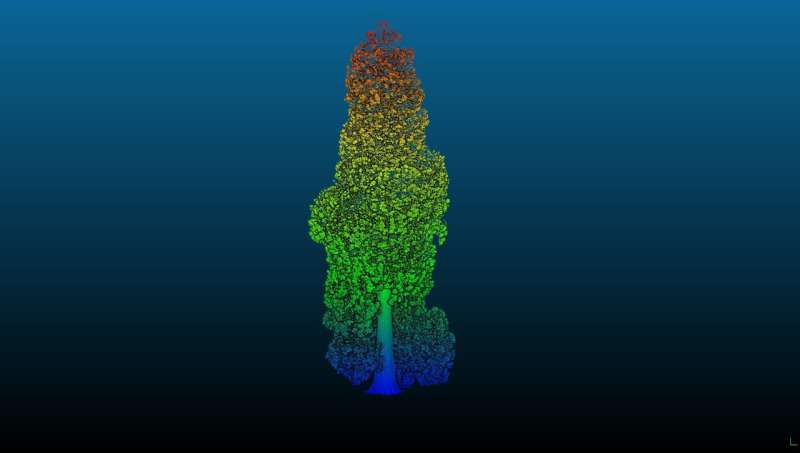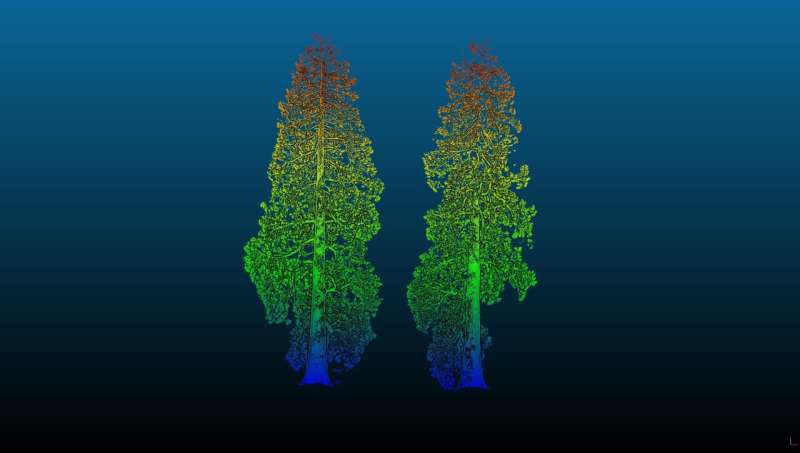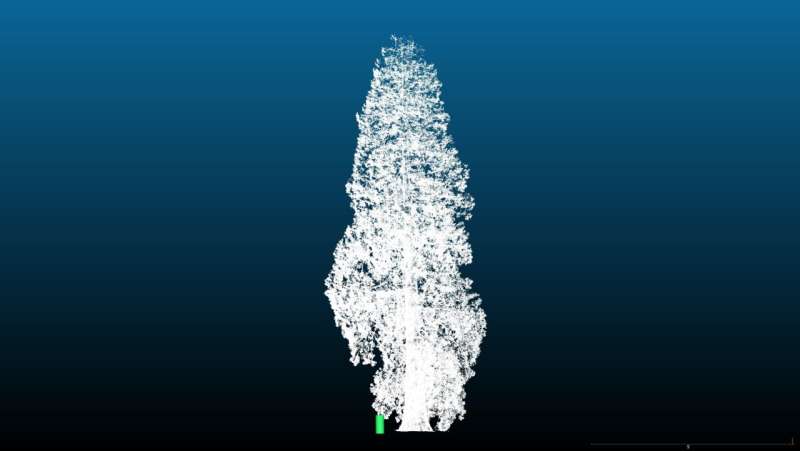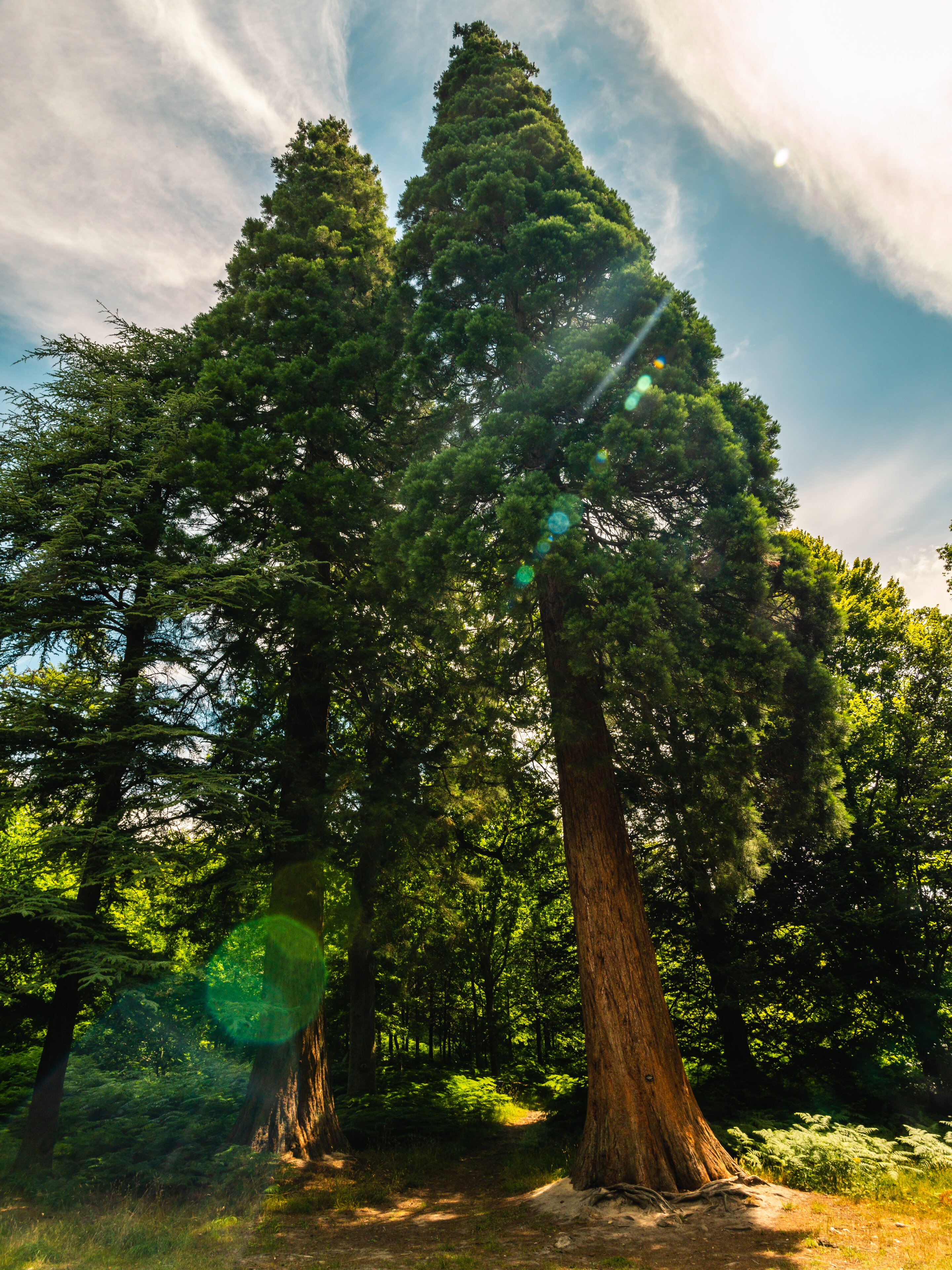Imported giant sequoia trees are well adapted to the UK, growing at rates close to their native ranges and capturing large amounts of carbon during their long lives, finds a new study led by UCL researchers with colleagues at the Royal Botanic Gardens, Kew.
The new research, published in Royal Society Open Science, found that the most massive species of redwood trees, Sequoiadendron giganteum, known as the giant sequoia, can potentially pull an average of 85 kilograms of carbon out of the atmosphere per year. Though introduced to the UK 160 years ago, this is the first time the trees’ growth rate and resilience in the UK have been analyzed.
There are an estimated half a million redwoods in the UK and more are being planted, partly due to their public appeal. In the wild, they are endangered with fewer than 80,000 giant sequoias remaining in their native California range.
Lead author Ross Holland, formerly a Master’s student at the UCL Department of Geography and now at East Point Geo, said, “Giant sequoias are some of the most massive organisms on Earth and in their native range make up some of the most carbon-dense forests in the world due to their great age. We found that UK redwoods are well adapted to the UK and able to capture a large amount of carbon dioxide. We hope that these findings can help guide decisions on future tree planting and management.”

The researchers emphasize that the most effective way to mitigate climate change is by reducing carbon emissions from burning fossil fuels. Trees can help by absorbing carbon emissions, but they also provide other important climate, ecosystem and well-being benefits.
Giant sequoias grow quickly and are also some of the longest-lived organisms in the world, keeping up their rapid growth throughout their 3,000-plus year lives. They can grow up to 90 meters tall, and while not quite the tallest in the world (that title goes to their closely-related cousin the coastal redwood), their wide trunks grow out, giving them the greatest volumes. In addition, they’re fire resistant, able to survive blazes that would wipe out forests of other tree species.
The trees grow best in their native range in California’s Sierra Nevada mountains, so the researchers wanted to gauge how they fare under UK climates, which are milder and with a wider range of rainfall. They compiled the first dedicated map of giant sequoias in the UK, mapping nearly 5,000 individual known trees.
The team visited three groves of trees, located at Wakehurst, the wild botanic garden of the Royal Botanic Gardens, Kew in Sussex, Havering Country Park in Essex, and Benmore Botanical Garden in Scotland. They set up terrestrial laser scanners to map the trees in 3D, enabling them to measure the heights and volumes very accurately and to create 3D models of 97 representative trees.

Co-author Dr. Phil Wilkes, formerly of UCL and now at Royal Botanic Gardens, Kew, said, “Using the latest laser scanning technology has allowed us to accurately ‘weigh’ these massive trees without having to cut them down. This means we can measure many more trees as well as revisit them in the future.”
The tallest tree they found measured about 180 feet tall (54.87 meters)—giant compared with most native UK species, but dwarfed by their American counterparts. This is in part because of the UK sequoias’ youth: the oldest giant sequoias in the UK are those at Benmore, the earliest dating to 1863.
Knowing when the trees were planted allowed the team to calculate their average growth rates under the varying climate conditions between the three UK sites. They found that the trees at Kew and Benmore grew at similar rates as their US counterparts, although growing slightly taller and slimmer at Benmore compared to Wakehurst, while at Havering the trees grew more slowly, likely due to less rainfall in the region and competition from dense local woodland.
Though giant sequoia stack up well for sequestering carbon, the researchers caution that planting trees requires long-term commitment, and consideration needs to be given to how well they will thrive in the UK’s changing climate in the next 160 years and beyond.

Senior author, Professor Mat Disney (UCL Geography), said, “These results give us an important baseline for estimating how well giant sequoias are doing in the UK climate. Currently, these trees are probably more important for their aesthetic and historical interest than they are for solving the climate crisis. But as more are planted we need to know how they will grow.
“The history of these trees in Britain is fascinating—initially as symbols of wealth and power, through to now being widely planted in parks and woodlands. They are iconic, but there is almost no work on how fast they grow or how well they will do in the UK’s changing climate. I find it amazing to see these giants dotted across the landscape and see how rapidly they are growing.”
More information:
Giant sequoia (Sequoiadendron giganteum) in the UK: carbon storage potential and growth rates, Royal Society Open Science (2024). DOI: 10.1098/rsos.230603. royalsocietypublishing.org/doi/10.1098/rsos.230603
Citation:
Giant sequoias are a rapidly growing feature of the UK landscape (2024, March 12)
retrieved 12 March 2024
from https://phys.org/news/2024-03-giant-sequoias-rapidly-feature-uk.html
This document is subject to copyright. Apart from any fair dealing for the purpose of private study or research, no
part may be reproduced without the written permission. The content is provided for information purposes only.


